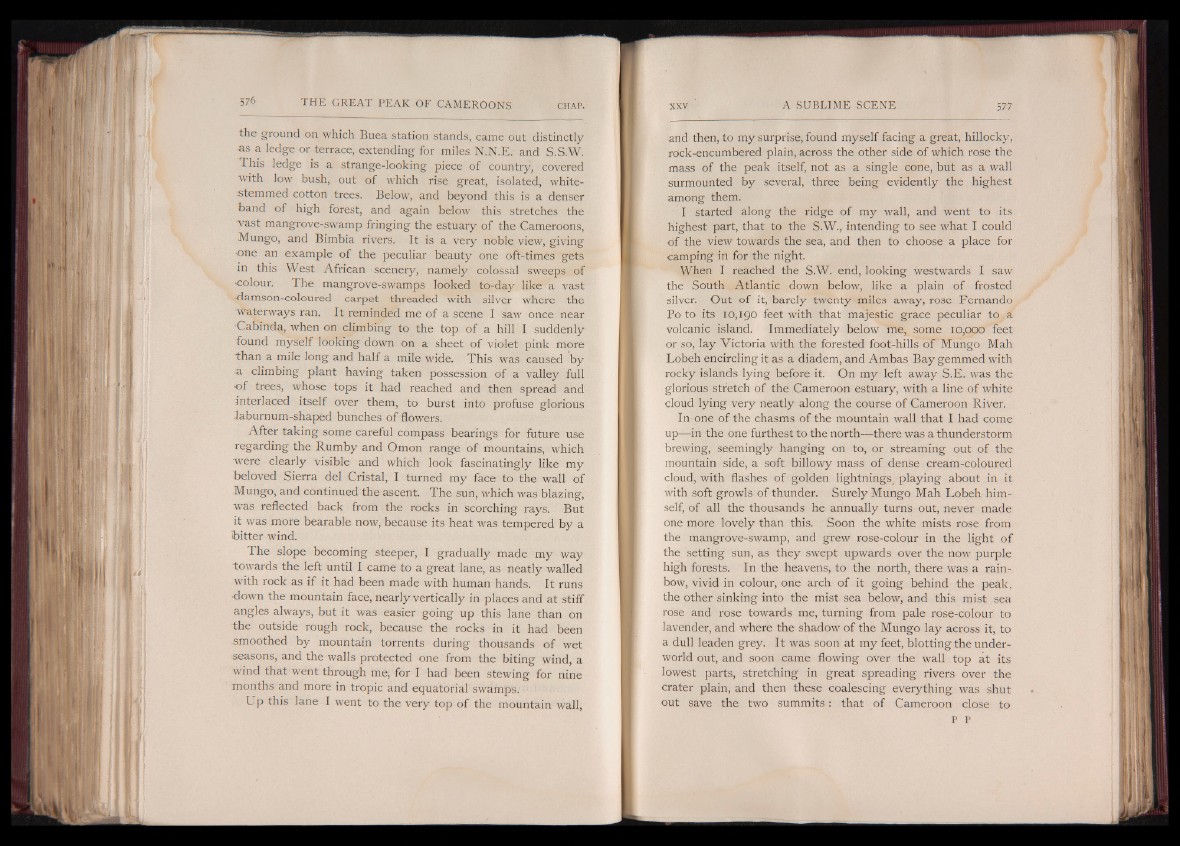
the ground on which Buea station stands, came out distinctly
as a ledge or terrace, extending for miles N.N.E. and S.S.W.
This ledge is a strange-looking piece of country, covered
with low bush, out of which rise great, isolated, whitestemmed
cotton trees. Below, and beyond this is a denser
band of high forest, and again below this stretches the
vast mangrove-swamp fringing the estuary of the Cameroons,
Mungo, and Bimbia rivers. It is a very noble view, giving
•one an example of the peculiar beauty one oft-times gets
in this West African scenery, namely colossal sweeps of
•colour. The mangrove-swamps looked to-day like a vast
-damson-coloured carpet threaded with silver where the
■waterways ran. It reminded me of a scene I saw once near
■Cabinda, when on climbing to the top of a hill I suddenly
found myself looking down on a sheet of violet pink more
"than a mile long and half a mile wide. This was caused by
■a climbing plant having taken possession of a valley full
•of trees, whose tops it had reached and then spread and
interlaced itself over them, to burst into profuse glorious
‘laburnum-shaped bunches of flowers.
After taking some careful compass bearings for future use
regarding the Rumby and Omon range of mountains, which
were clearly visible and which look fascinatingly like my
beloved Sierra del Cristal, I turned my face to the wall of
Mungo, and continued the ascent. The sun, which was blazing,
was reflected back from the rocks in scorching rays. But
it was more bearable now, because its heat was tempered by a
bitter wind.
The slope becoming steeper, I gradually made my way
towards the left until I came to a great lane, as neatly walled
with rock as if it had been made with human hands. It runs
■down the mountain face, nearly vertically in places and at stiff
angles always, but it was easier going up this lane than on
the outside rough rock, because the rocks in it had been
smoothed by mountain torrents during thousands of wet
seasons, and the walls protected one from the biting wind, a
wind that went through me, for I had been stewing for nine
months and more in tropic and equatorial swamps.
Up this lane I went to the very top of the mountain wall,
and then, to my surprise, found myself facing a great, hillocky,
rock-encumbered plain, across the other side of which rose the
mass of the peak itself, not as a single cone, but as a wall
surmounted by several, three being evidently the highest
among them.
I started along the ridge of my wall, and went to its
highest part, that to the S.W., intending to see what I could
of the view towards the sea, and then to choose a place for
camping in for the night.
When I reached the S.W. end, looking westwards I saw
the South Atlantic down below, like a plain of frosted
silver. Out of it, barely twenty miles away, rose Fernando
Po to its 10,190 feet with that majestic grace peculiar to a
volcanic island. Immediately below me, some 10,000 feet
or so, lay Victoria with the forested foot-hills of Mungo Mah
Lobeh encircling it as a diadem, and Ambas Bay gemmed with
rocky islands lying before it. On my left away S.E. was the
glorious stretch of the Cameroon estuary, with a line of white
cloud lying very neatly along the course of Cameroon River.
In one of the chasms of the mountain wall that I had come
up— in the one furthest to the north— there was a thunderstorm
brewing, seemingly hanging on to, or streaming out of the
mountain side, a soft billowy mass of dense. cream-coloured
cloud, with flashes of golden lightnings, playing about in it
with soft growls of thunder. Surely Mungo Mah Lobeh himself,
of all the thousands he annually turns out, never made
one more lovely than this. Soon the white mists rose from
the mangrove-swamp, and grew rose-colour in the light of
the setting sun, as they swept upwards over the now purple
high forests. In the heavens, to the north, there was a rainbow,
vivid in colour, one arch of it going behind the peak,
the other sinking into the mist sea below, and this mist sea
rose and rose towards me, turning from pale rose-colour to
lavender, and where the shadow of the Mungo lay across it, to
a dull leaden grey. It was soon at my feet, blotting the underworld
out, and soon came flowing over the wall top at its
lowest parts, stretching in great spreading rivers over the
crater plain, and then these coalescing everything was shut
out save the two summits: that of Cameroon close to